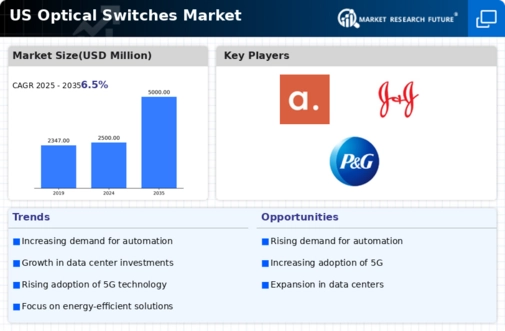Growing Data Traffic
The optical switches market is experiencing a surge in demand driven by the exponential growth of data traffic across various sectors. With the increasing reliance on cloud computing, streaming services, and big data analytics, the need for high-capacity data transmission is paramount. Reports indicate that data traffic in the US is projected to grow at a CAGR of approximately 25% over the next five years. This growth necessitates the deployment of advanced optical switching technologies to manage and route data efficiently. As organizations seek to enhance their network infrastructure, the optical switches market is likely to benefit significantly from this trend, as these switches provide the necessary bandwidth and speed to accommodate rising data demands.
Emerging Applications in IoT
The optical switches market is likely to expand. This is due to the emergence of new applications in the Internet of Things (IoT). As IoT devices proliferate, the demand for efficient data transmission and processing becomes critical. Optical switches offer the necessary speed and bandwidth to support the vast amounts of data generated by IoT devices. The US is witnessing a rapid increase in IoT deployments, with estimates suggesting that there will be over 30 billion connected devices by 2025. This growth presents a substantial opportunity for the optical switches market, as businesses and industries seek to implement robust networking solutions that can handle the complexities of IoT ecosystems.
Advancements in Telecommunications
The optical switches market is poised for growth due to ongoing advancements in telecommunications infrastructure. The transition from traditional copper-based systems to fiber-optic networks is accelerating, driven by the need for faster and more reliable communication. The Federal Communications Commission (FCC) has reported that fiber-optic connections are expanding rapidly, with over 40% of US households now having access to high-speed fiber services. This shift is prompting telecommunications companies to invest in optical switching technologies that can support higher data rates and lower latency. Consequently, The optical switches market is likely to see increased adoption. This is due to service providers upgrading their networks to meet consumer expectations for seamless connectivity.
Regulatory Support for Fiber Optics
The optical switches market is likely to benefit from regulatory support aimed at promoting fiber-optic technology. Various government initiatives are encouraging the expansion of high-speed internet access, particularly in underserved areas. The US government has allocated substantial funding to improve broadband infrastructure, which includes the deployment of fiber-optic networks. This regulatory environment is conducive to the growth of the optical switches market, as it incentivizes telecommunications companies to invest in advanced switching technologies. As these initiatives gain momentum, the optical switches market may see increased demand from service providers looking to enhance their network capabilities and meet regulatory requirements.
Increased Investment in Data Centers
The optical switches market is benefiting from a notable increase in investment in data centers across the US. As businesses continue to digitize their operations, the demand for efficient data storage and processing capabilities is rising. According to industry reports, the US data center market is expected to reach a valuation of $100 billion by 2026, with a significant portion allocated to upgrading network infrastructure. Optical switches play a crucial role in enhancing data center performance by enabling high-speed data transfer and reducing bottlenecks. This trend suggests that the optical switches market will experience robust growth as data centers seek to optimize their operations and improve service delivery.













Leave a Comment